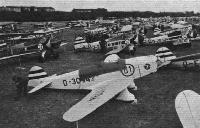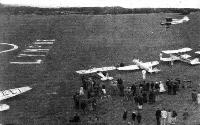
Описание
Страна : Германия
Год : 1933
Двухместный туристический и учебно-тренировочный легкий самолет
Fieseler Fi 1, 2, 3, 4 и 5
<...>
Первый успех пришел только к самолету F 5 - двухместному учебно-тренировочному и туристическому самолету, представлявшему собой свободнонесущий низкоплан смешанной конструкции, с частично полотняной обшивкой. Хвостовое оперение - обычное расчалочное, шасси - трехопорное неубирающееся, с хвостовым костылем, а в состав силовой установки включили рядный двигатель Hirth HM.60. Фюзеляж имел две закрытые кабины, управление было полностью дублированным. Задняя часть крыла по всему размаху имела закрылки, внешние секции которых могли работать дифференциально, исполняя роль элеронов.
ТАКТИКО-ТЕХНИЧЕСКИЕ ХАРАКТЕРИСТИКИ
Fieseler F5R
Тип: двухместный туристический и учебно-тренировочный легкий самолет
Силовая установка: один четырехцилиндровый рядный ПД с перевернутым блоком цилиндров Hirth HM.60 мощностью 80 л. с. (60 кВт)
Летные характеристики: макс. скорость 200 км/ч; практический потолок 4000 м; дальность 600 км
Масса: пустого 395 кг; максимальная взлетная 660 кг
Размеры: размах крыла 10,00 м; длина 6,60 м; высота 2,30 м; площадь крыла 13,60 m2
Описание:
- Fieseler Fi 1, 2, 3, 4 и 5
- Flight, October 1933
THE "FIESLER 5" MONOPLANE
Фотографии
-
Aeroplane Monthly 1999-05 / M.Hooks - Personal album /Archive colour/
Регистрационный номер: HB-ELF A rarity, the Fieseler F.5R HB-ELF was registered in Switzerland in April 1946, having survived the war as D-EUJA. Seen at Basle on May 30, 1962, unfortunately placed for photography, it was destroyed in a crash on July 27, 1968, in France.
-
Flight 1933-11 / Flight
View from above of the "Fiesler 5" monoplane. It is fitted with a 60-h.p. H.M. 60 engine.
-
Мировая Авиация 130
Регистрационный номер: D-ENAZ Аэродинамически чистые обводы Fieseler F 5 - наглядное доказательство того, что проектировавший его специалист был высококлассным авиаконструктором. Крыло имело на задней кромке закрылки по всему размаху, внешние их секции работали дифференциально как элероны.
-
Flight 1933-08 / Flight
SOME COMPETITORS: Kurt BIey on the Fieseler 5.
-
Flight 1934-06 / Flight
Регистрационный номер: D-3094 DEUTSCHLANDFLUG, 1934: Some of the machines in the German tour at Tempelhof. The new Fieseler monoplane can be seen in the foreground.
-
Flight 1933-11 / Flight
Side and front views of the new "Fiesler 5" low-wing monoplane in flight.
-
Flight 1937-08 / Flight
The Dutch De Schelde with Gypsy Major engine was unfortunately eliminated in the heats. The German Fieseler F.5.R., seen nearer to the hangar, suffered a similar fate.
Другие самолёты на фотографии: De Schelde S.12 - Нидерланды - 1937
-
Flight 1937-08 / Flight
Between heats and final mechanics tinkered, while spectators watched demonstrations of the Wicko, seen flying above, the Porterfield "70" and the German Fieseler with 70 h.p. Hirth engine.
Другие самолёты на фотографии: Foster Wikner Wicko - Великобритания - 1936Porterfield 35 Flyabout - США - 1936
-
Flight 1932-10 / Flight
Of the two machines shown in 3 that in the background is the Messerschmitt M.31, a most graceful-looking monoplane, while in the foreground is the new Fieseler 4 with Argus AS 16 horizontally-opposed engine.
Другие самолёты на фотографии: Messerschmitt BFW M.29 / M.31 - Германия - 1931
-
Air Pictorial 1973-06
Регистрационный номер: ES-ALF This was taken at Tallinn airport circa 1935 and depicts aircraft of the Estonian Aero Club. They are: ES-RWD, RWD-8, a slightly modified machine constructed in Estonia; ES-EPP, OGL-2; ES-LDM, OGL-1; ES-PON, OGL-1; ES-ALF, type unidentified [Fieseler F5R]; ES-AGU, Raab Schwalbe II; and ES-EHA, Raab Schwalbe II.
Другие самолёты на фотографии: Post, Org, Neudorf PON-1 - Эстония - 1934Post, Org, Neudorf PON-2 - Эстония - 1934Raab-Katzenstein RK.26 Tigerschwalbe - Германия - 1929RWD RWD-8 - Польша - 1932
- Фотографии









